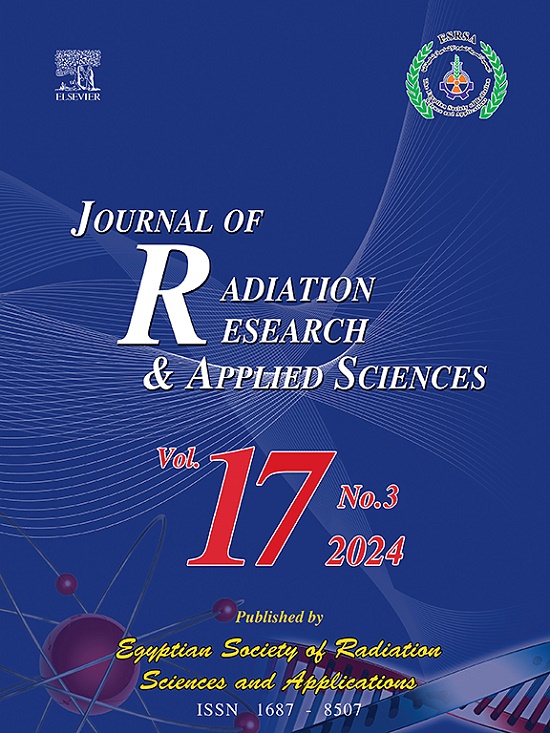Improving genetic variation, shelf-life and functional properties in Dioscorea esculenta (Lour) burk using recurrent irradiation
IF 1.7
4区 综合性期刊
Q2 MULTIDISCIPLINARY SCIENCES
Journal of Radiation Research and Applied Sciences
Pub Date : 2025-03-23
DOI:10.1016/j.jrras.2025.101453
引用次数: 0
Abstract
Ionising radiation has become an effective tool to generate novel genetic variation and reduce postharvest losses in roots and tuber crops. The present study investigated the effect of gamma irradiation and re-irradiation on growth and yield characters, shelf-life and functional characteristics of Dioscorea esculenta. Tubers of two accessions SO89021 and TA97166 were irradiated at 10, 20, or 30 Gy. The M1V1 population was replanted to produce the M1V2 population and the tubers harvested were re-irradiated at 30 or 40 Gy to induce sufficient genetic variation. At 12 months, M2V1 tubers were cured for two weeks before determination of proximate composition, physicochemical and functional properties. For the shelf-life study, selected tubers from M2V1 were re-irradiated at 0, 80, 100, or 120 Gy and monitored for rots, sprouts, and weight loss for 14 weeks. Initial irradiation at 0–30 Gy did not have a significant effect on the morphological traits of the plants. However, re-irradiation at 40 Gy decreased plant height, number of leaves, tuber weight, and length compared to the controls. The decrease in tubers in accession TA97166 resulted in a significant increase (p ≤ 0.05) in tuber weight and width at 40 Gy. Similarly, starch content, solubility, and swelling power of the flour decreased with increasing irradiation dose. Gamma irradiation significantly (p ≤ 0.05) affected the gelatinization viscosity, maximum viscosity and breakdown viscosity. This study demonstrated that gamma irradiation can improve tuber size and some functional properties of D. esculenta.
利用反复辐照改善薯蓣的遗传变异、贮藏期和功能特性
电离辐射已成为产生新的遗传变异和减少块根和块茎作物采后损失的有效工具。研究了γ辐照和再辐照对薯蓣生长、产量、货架期和功能特性的影响。对SO89021和TA97166两个材料的块茎进行了10、20和30 Gy的辐照。将M1V1群体移栽产生M1V2群体,收获的块茎在30或40 Gy下再次照射,以诱导充分的遗传变异。在12个月时,M2V1块茎被固化两周,然后测定其近似成分、物理化学和功能特性。在保质期研究中,从M2V1中挑选的块茎在0、80、100或120 Gy的辐射下再次照射,并监测14周内的腐烂、发芽和体重下降情况。0 ~ 30 Gy初始辐照对植株形态性状无显著影响。然而,与对照相比,40 Gy的再辐照降低了植株高度、叶片数量、块茎重量和长度。40gy处理下,TA97166块茎数量减少,块茎质量和块茎宽度显著增加(p≤0.05)。同样,随着辐照剂量的增加,面粉的淀粉含量、溶解度和溶胀力也降低。γ辐照对糊化粘度、最大粘度和击穿粘度有显著影响(p≤0.05)。本研究表明,γ辐照可以提高黄瓜块茎的大小和某些功能特性。
本文章由计算机程序翻译,如有差异,请以英文原文为准。
求助全文
约1分钟内获得全文
求助全文
来源期刊

Journal of Radiation Research and Applied Sciences
MULTIDISCIPLINARY SCIENCES-
自引率
5.90%
发文量
130
审稿时长
16 weeks
期刊介绍:
Journal of Radiation Research and Applied Sciences provides a high quality medium for the publication of substantial, original and scientific and technological papers on the development and applications of nuclear, radiation and isotopes in biology, medicine, drugs, biochemistry, microbiology, agriculture, entomology, food technology, chemistry, physics, solid states, engineering, environmental and applied sciences.
 求助内容:
求助内容: 应助结果提醒方式:
应助结果提醒方式:


